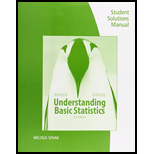
For each hypothesis test in Problems 3-10, please provide the following information:
What is the level of significance? State the null and alternate hypotheses.
Check Requirements What sampling distribution will you use? What assumptions are you making? What is the value of the sample test statistic?
Find (or estimate) the P-value. Sketch the sampling distribution and show the area corresponding to the P-value.
Based on your answers in parts (i)—(iii), will you reject or fail to reject the null hypothesis? Are the data statistically significant at level
Interpret your conclusion in the context of the application.
Note: For degrees of freedom d.f. not in the Student's t table, use the closest d.f that is smaller. In some cases, this choice will increase the P-value by a small amount or increase the length of a confidence interval, thereby making the answer slightly more “conservative." Answers may vary due to rounding.
Marketing: Sporting Goods A marketing consultant was hired to visit a random sample of five sporting goods stores across the state of California. Each store was part of a large franchise of sporting goods stores. The consultant taught the managers of each store better ways to advertise and display their goods. The net sales for 1 month before and 1 month after the consultant's visit were recorded as follows for each store (in thousands of dollars):
| Store | 1 | 2 | 3 | 4 | 5 |
| Before visit | 57.1 | 94.6 | 49.2 | 77.4 | 43.2 |
| After visit | 63.5 | 101.8 | 57.8 | 81.2 | 41.9 |
Do the data indicate that the average net sales improved? (Use
Want to see the full answer?
Check out a sample textbook solution
Chapter 10 Solutions
Student Solutions Manual for Brase/Brase's Understanding Basic Statistics, 7th
- A marketing agency wants to determine whether different advertising platforms generate significantly different levels of customer engagement. The agency measures the average number of daily clicks on ads for three platforms: Social Media, Search Engines, and Email Campaigns. The agency collects data on daily clicks for each platform over a 10-day period and wants to test whether there is a statistically significant difference in the mean number of daily clicks among these platforms. Conduct ANOVA test. You can provide your answer by inserting a text box and the answer must include: also please provide a step by on getting the answers in excel Null hypothesis, Alternative hypothesis, Show answer (output table/summary table), and Conclusion based on the P value.arrow_forwardA company found that the daily sales revenue of its flagship product follows a normal distribution with a mean of $4500 and a standard deviation of $450. The company defines a "high-sales day" that is, any day with sales exceeding $4800. please provide a step by step on how to get the answers Q: What percentage of days can the company expect to have "high-sales days" or sales greater than $4800? Q: What is the sales revenue threshold for the bottom 10% of days? (please note that 10% refers to the probability/area under bell curve towards the lower tail of bell curve) Provide answers in the yellow cellsarrow_forwardBusiness Discussarrow_forward
- The following data represent total ventilation measured in liters of air per minute per square meter of body area for two independent (and randomly chosen) samples. Analyze these data using the appropriate non-parametric hypothesis testarrow_forwardeach column represents before & after measurements on the same individual. Analyze with the appropriate non-parametric hypothesis test for a paired design.arrow_forwardShould you be confident in applying your regression equation to estimate the heart rate of a python at 35°C? Why or why not?arrow_forward
 Glencoe Algebra 1, Student Edition, 9780079039897...AlgebraISBN:9780079039897Author:CarterPublisher:McGraw Hill
Glencoe Algebra 1, Student Edition, 9780079039897...AlgebraISBN:9780079039897Author:CarterPublisher:McGraw Hill College Algebra (MindTap Course List)AlgebraISBN:9781305652231Author:R. David Gustafson, Jeff HughesPublisher:Cengage Learning
College Algebra (MindTap Course List)AlgebraISBN:9781305652231Author:R. David Gustafson, Jeff HughesPublisher:Cengage Learning

